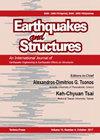强地震作用下钢结构粘性阻尼器的战略性横向布置
IF 1.4
4区 工程技术
Q3 ENGINEERING, CIVIL
引用次数: 0
摘要
附加被动阻尼器被广泛用于改善建筑物在地震作用下的结构性能。然而,如果减振器反力引起的轴向力在柱中没有正确路由,则增加的阻尼可能会适得其反。一些研究人员致力于优化沿宽度方向的阻尼器布置,以改善轴向柱力的传递路径。然而,这些研究大多局限于基于设计的地震级别,很少有研究对建筑在强震作用下的倒塌性能进行评估。本文针对建筑在倒塌状态下的性能,探讨粘性阻尼器的策略宽度布局方法。对两个不同楼层的现实钢结构建筑进行建模和比较,以探索更高的模式效果。根据经典的阻尼器分布方法,设计了四种不同的阻尼器布置方案。考虑了建筑物的远断层和近断层地震环境。采用增量动力分析(IDA)对钢结构改造后的结构进行了倒塌概率分析和塑性机理分析。本文章由计算机程序翻译,如有差异,请以英文原文为准。
Strategic width-wise arrangement of viscous dampersin steel buildings under strong earthquakes
Supplemental passive dampers are widely employed to improve the structural performance of buildings under seismic excitations. Nevertheless, the added damping could be counter-productive if the axial forces induced by the damper reaction forces are not routed properly in the columns. A few researchers engaged to optimize the width-wise damper arrangement to improve the delivered path of the axial column forces. However, most of these studies are limited under the design-based seismic level and few of them has evaluated the collapse performance of buildings under strong earthquakes. In this paper, the strategic width-wise placement method of viscous dampers is explored regarding the building performance under collapse state. Two realistic steel buildings with different storeys are modelled and compared to explore higher mode effects. Each building is designed with four different damper arrangement scenarios based on a classic damper distribution method. Both a far-fault and a near-fault seismic environment are considered for the buildings. Incremental Dynamic Analysis (IDA) is performed to evaluate the probability of collapse and the plastic mechanism of the retrofitted steel buildings.
求助全文
通过发布文献求助,成功后即可免费获取论文全文。
去求助
来源期刊

Earthquakes and Structures
ENGINEERING, CIVIL-ENGINEERING, GEOLOGICAL
CiteScore
2.90
自引率
20.00%
发文量
0
审稿时长
>12 weeks
期刊介绍:
The Earthquakes and Structures, An International Journal, focuses on the effects of earthquakes on civil engineering structures. The journal will serve as a powerful repository of technical information and will provide a highimpact publication platform for the global community of researchers in the traditional, as well as emerging, subdisciplines of the broader earthquake engineering field. Specifically, some of the major topics covered by the Journal include: .. characterization of strong ground motions, .. quantification of earthquake demand and structural capacity, .. design of earthquake resistant structures and foundations, .. experimental and computational methods, .. seismic regulations and building codes, .. seismic hazard assessment, .. seismic risk mitigation, .. site effects and soil-structure interaction, .. assessment, repair and strengthening of existing structures, including historic structures and monuments, and .. emerging technologies including passive control technologies, structural monitoring systems, and cyberinfrastructure tools for seismic data management, experimental applications, early warning and response
 求助内容:
求助内容: 应助结果提醒方式:
应助结果提醒方式:


